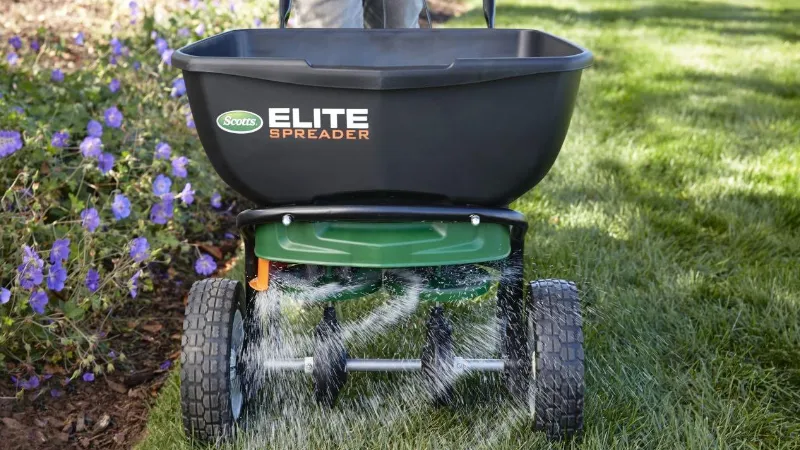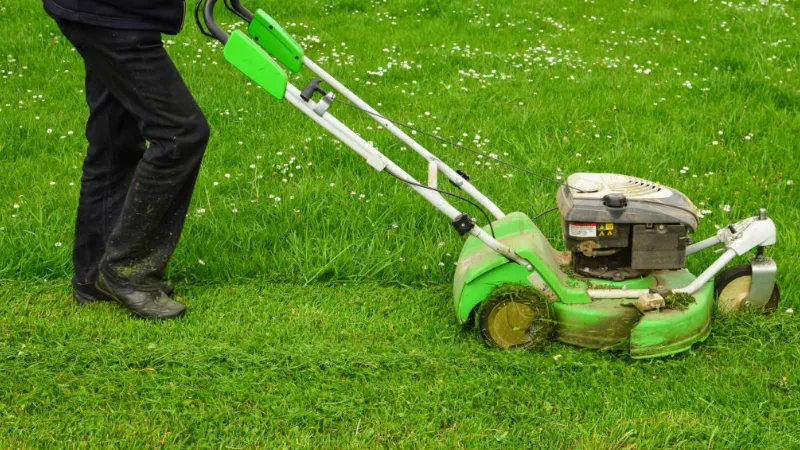It takes time and work to maintain a lush, healthy lawn. To keep a beautiful lawn, many tasks, such as fertilizing and mowing, must be completed during the spring and summer months. However, early fall and late summer can both be very busy times.
By overseeding an established lawn with seed, now is the ideal time to start preparing for a healthy stand of grass for the upcoming season. So, how to plant grass seed on existing lawns? Below will also give you tips on how to stop birds from eating grass seed and how to plant grass seed like a pro.
How to plant grass seed on existing lawns? You need to make a preparation before you over-seed, prepare the area, plant the seed, and water the lawn regularly.
Please read on for more detailed information.
How to Plant Grass Seed on Existing Lawns?
Here is the step-by-step guide:
Before You Over-Seed
Consider for a moment what might be resulting in the bare or thin areas. It’s one thing to notice bare or thin spots on your lawn as a result of the daily pressures that are put on it. Observing bare, brown, or unhealthy patches that are the result of other issues like soil compaction, inadequate sunlight, a fungal infection, too much thatch, poor soil quality, or poor drainage is one thing; spotting these areas is quite another. It’s important to evaluate your yard before you put in the effort to prepare it and plant the seed because if the issue isn’t correctly identified and fixed, you might end up with even more bare or thin spots. Are you unsure of the root of your issues? Make contact with Fit Turf and ask us to assess your spaces. In addition to providing you with expert advice, we will suggest the most practical, best solutions to your problems.
The types of grass seed you choose must also be carefully considered. You won’t get anything but disappointment if you plant a grass seed variety that won’t grow in your region. Choose native grasses or grasses that have proven to be successful in your area. Both the Detroit-Metro area and the Denver-Metro area need cool-season grasses, such as Kentucky bluegrass and tall or fine fescue grasses, but each region has different requirements due to factors like altitude, soil types, climate, and more. Talk to the university extension office in your area for a moment. Making the incorrect choice of grass seed for your area can result in headaches that can be avoided with a little bit of research.
To develop your lawn maintenance strategy, learn how to identify crabgrass. Below will give you a full explanation of what is crabgrass.

Prepare the Area
It’s crucial to properly prepare the area before you overseed your lawn. This entails deeply watering, mowing, bagging the grass clippings, and raking. Set your mower to the lowest setting before cutting your lawn. Because too-long grass prevents the grass seed from making contact with the soil where it needs to grow in order to grow, Rake the soil loose after removing the grass clippings.
To ensure proper oxygen and nutrient flow, it’s also crucial to aerate compacted soils. For help setting their lawns up for success in the spring, many homeowners use Fit Turf’s aeration and over-seeding services. The soil is primed and a layer of grass seed with good seed-to-soil contact is deposited using this two-step procedure, which delivers a one-two punch. To find out more about the services we offer, get in touch with us today.
Use the proper aeration tool, such as a plug or spike aerator, when aerating the soil by hand. To ensure proper water, air, and nutrient flow, your DIY aeration tool needs to remove soil plugs that are 2 to 3 inches deep, 0.5 to 0.75 inches in diameter, and roughly 2 to 3 inches apart. If a fertilizer is not mixed with your grass seed, you must also prepare the area for over-seeding with core aeration and apply a starter fertilizer with high phosphorous levels. Find a good 16-16-8 fertilizer. But, How Long Does Grass Seed Last?

Plant the Seed
Your seed of choice should be broadcast. You can apply this by hand or with a spreader to the areas of your lawn that have been prepared. Verify the instructions on the grass seed packaging to make sure you’re using the right spreader setting for the grass seed type. Use a leaf rake to gently rake the freshly planted grass seeds into the prepared soil.
Water
Water your lawn thoroughly after you’ve applied the grass seed. Maintain your regular, light lawn watering schedule of up to twice daily. Within 10 to 14 days, your seedlings should start to sprout; in the interim, water your plants frequently and soak the top inch of soil. After germination, you can water less frequently, but make sure that the water soaks deeper into the ground to promote the development of deep roots.
Can you mow wet grass? Short answer: No. Whether it’s early morning and the lawn is still dewy, a rainstorm just ended, or you just ran your sprinklers, you should skip the mow for now. Please read on for more detailed information.
How to Stop Birds Eating Grass Seed?
You worked hard to plant grass seed in the hope of having a lush, green lawn in a few weeks, so you don’t want the neighborhood wildlife to come along and steal it all.
Here are a few ideas you might like to try in order to stop birds eating grass seed: (in no particular order)
- Bird scarers
- Straw or mulch
- Fleece
- Decoy feeders
- Shiny, spinning objects such as CD’s
- Polythene sheeting
- Dedicated bird netting
- Fake owls or hawks
- Plant extra seeds

How to Plant Grass Seed Like a Pro?
It’s simple to get carried away because the steps for planting grass seed are so simple. However, as you have learned, planning is essential to getting the backyard lawn of your dreams.
Here’s a reminder:
- Prepare early
- Prepare well
- Buy the best grass seed for your budget and location
- Plant grass seed in the right season
- Water well to start germination of seed
If you want an extra tip, it’s this: Use the best equipment you can for the job, as this will help you plant grass seed that will reward you with seasons of enjoyment.
Return to Regular Maintenance
Keep your newly revived lawn looking its best with a regular, comprehensive maintenance plan that includes diligent watering, best mowing practices and proactive overseeding. A simple weekday lawn maintenance schedule can keep your lawn lush and your weekends free.
For a simple, all-in-one approach to a thicker lawn, you can put your lawn on the fast track with Pennington Lawn Booster. This easy-to-use product simplifies overseeding to give your lawn the boost it needs. Your lawn will grow faster, thicker, and greener than regular grass in just one application, guaranteed.
Available in formulas for sun & shade or tall fescue lawns, Lawn Booster combines three essentials: seed, fertilizer and soil enhancer. Pure-bred Pennington Smart Seed with lime enhancement adds beauty and sustainability and is the product of years of breeding and research. These water-saving grasses require up to 30% less water once they are established than regular grasses. All through the years that your lawn will exist, that is. In addition, they don’t need water for up to three weeks to stay green. That means less work and more leisure time for you.
By stabilizing nitrogen in the soil, the premium fertilizer in Lawn Booster helps to prevent leaching and other nitrogen losses to the environment. Without any additional fertilizer inputs from you, your seed receives nitrogen for immediate feeding as well as extended feeding for up to eight weeks. Additionally, Lawn Booster’s soil-enhancing gypsum improves soil conditions to promote better root growth, allowing your freshly boosted lawn to thrive and become the talk of the neighborhood.
Don’t wait until your lawn looks less than its best to overseed if you want the lawn of your dreams. Either all at once or in stages, give your lawn the boost it needs. To help you maintain the healthiest possible lawn, Pennington is here with top-quality grass seed and lawn care products.
If you have any questions, please leave a comment. My Prime Home tries to give you the best home improvement information. Don’t forget to share the post. Thank you for reading.

FAQs
Can You Just Sprinkle Grass Seed on Top of Your Existing Lawn?
While it’s possible to simply sow the new grass seed over your existing lawn, taking the time to prepare your lawn beforehand will increase the likelihood of seed germination and improve your end result.
How Often Should You Overseed Your Lawn?
It is best to over-seed your lawn twice a year, once in the spring and once in the autumn. To get ready for the heavy use and wear and tear during the summer months, you need to overseed in the spring. Overseeding in the fall aids in mending any holes and bald spots brought on by the summer.
Should You Mix Grass Seed With Topsoil?
If you’re looking for a quick answer, yes, you should mix grass seed with topsoil for small areas of your garden and other applications.
Should I Put Topsoil over Grass Seed?
Grass seed shouldn’t be covered with top soil, but you can add a thin layer of organic matter to aid in germination. ‘Yamaguchi advises against covering newly planted grass seed with topsoil.
Read about



